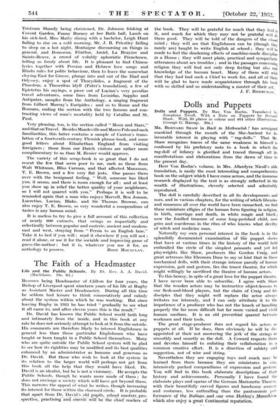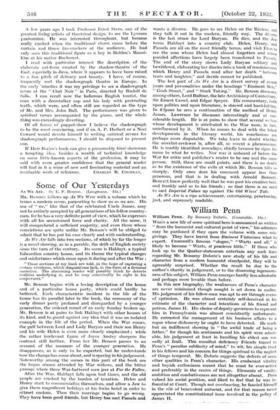Dolls and Puppets Dolls and Puppets. By Max Von Boehn.
Translated by Josephine Nicoll. With a Note on Puppets by Bernard Shaw. With 30 plates in colour and 464 other illustrations, (George GA-larrap. 30s.) MR. BERNARD SHAW in Back .to Methuselah ! has arraigned mankind through the mouth of the She-Ancient for its incurable interest in playing with " rag-dolls." That Mr. Shaw recognizes traces of the -same weakness in himself is confessed by his prefatory note, to a book in which the rag-doll of infancy is glorified and traced through all its manifestations and elaborations from the dawn of time to the present day.
Herr Von Boehh's volume, in Mrs. Allardyce Nicoll's able translation, is easily the most interesting and comprehensive book on the subject which I have come across, and the immense research displayed by the text is as strongly reflected in the wealth of illustrations,. cleverly selected and admirably reproduced.
The doll is carefully described in all its developments and uses, and in various chapters, for the writing of which libraries and museums all over the world have been ransacked, we find these miniature effigies of the human form figuring in religion, in birth, marriage and death, in white magic and black ; now the fondled treasure of some long-perished child, now grim and murderous in the rites of who knoWs what devilry of witch and medicine man.
Naturally my own personal interest in the book is in the splendidly documented examination of the puppet shows that have at various times in the history of the world held enthralled the circle of the simplest peasants and yet led
playwrights like Shaw, producers like Gordon Craig, and great actresses like Eleonora Duse to say or hint that in these
mechanical dolls, with their strange intense parody of human expreSion, gait and gesture, lies the truest theatre, for which might willingly be sacrificed the theatre of human actors. To this heresy, in spite of a great love for the puppet theatre, I have never been able to subscribe. I agree with Shaw that the wooden actors may be instructive object-lessons to our flesh-and-blood players, but the claim of Craig and his
disciples that they might well replace the actor always irritates me intensely, and I can only attribute it to the inipatience of a producer who has not the knack of handling properly the far more difficult but far more varied and vivid human medium. It is an old proverbial quarrel between workmen and their tools.
The great stage-producer does not regard his actors as puppets at all. If he does, then obviously he will be dis- appointed at their not answering the jerk of the strings is smoothly and smartly as the doll. A Coward respects them and devotes - himself to enlisting their -collaboration in a common creative effort. It is a direction of sublety and suggestion, not of wire and string.
Nevertheless they are engaging toys and much may be learned from them because. they are miniatures in sire, intensively packed compendiums of expression and gesture.
You will find in this book elaborate descriptions of their history and achievements. Personally I have found the elaborate plays and operas of the German Marionette Theatre. with their beautifully carved figures and handsome scenery and costumes, less enthralling than the pantomimic per- formance of the .Italians And _rug own _Holden'A Mannikin*
which also enjoy a great Continental reputation.
A few years ago I took Professor Ernst Stern, one of the greatest living artists of theatrical design, to see the Lyceum pantomime. He was interested throughout, but became really excited when the traditional clown came before the curtain and threw fire-crackers at the audience. He had only seen this traditional figure as a boy in Holden's Manni- kins at his native Bucharest.
I read with particular interest the description of the elaborate art-form created by the shadow-theatre of. the East, especially in Java, where it appears to have been raised to a fine pitch of delicacy and beauty. I have, of course, frequently met the shadowgraph theatre in Europe. In the early 'nineties it was my privilege to see a shadowgraph revue at the Chat Noir " in Paris, directed by Rudolf de Salis. I can recall now the ludicrous English tourist, the man with a deerstalker cap and his lady with protruding teeth, which were, and often still are regarded as the type of Mr. and Mrs. John Bull. The performance was given to spirituel verses accompanied by the piano, and the whole thing was exceedingly diverting.
Of all forms of puppet-show I believe the shadowgraph to be the most convincing, and if an A. P. Herbert or a Noel Coward would devote himself to writing satirical revues for shadowgraph performances, I should be disposed to present one.
If Herr Bochtis book can give a presumably blasé showman a tempting idea, besides a wealth of technical knowledge on some little-known aspects of the profession, it may be said with even greater confidence that the general reader will find in it a mine of new and fascinating material and an















































 Previous page
Previous page